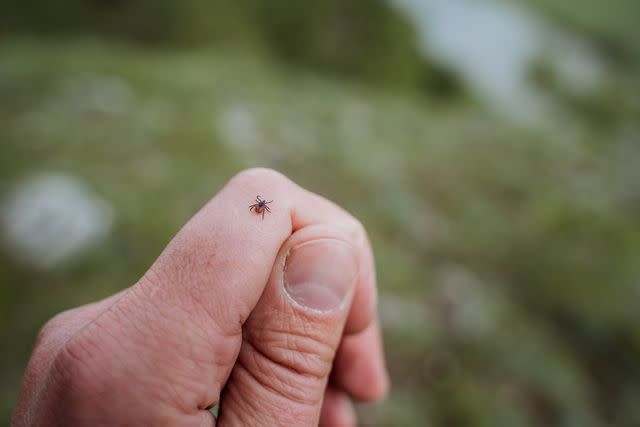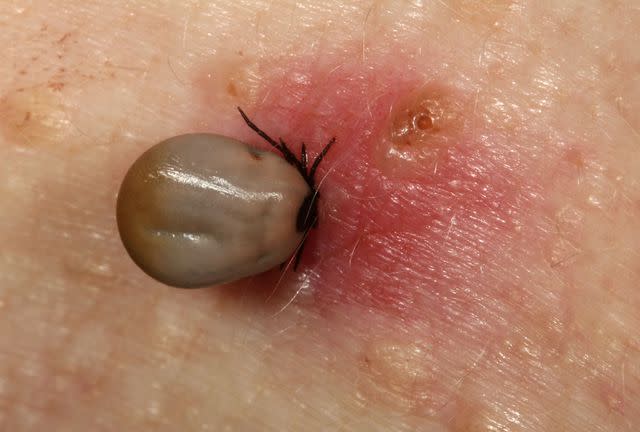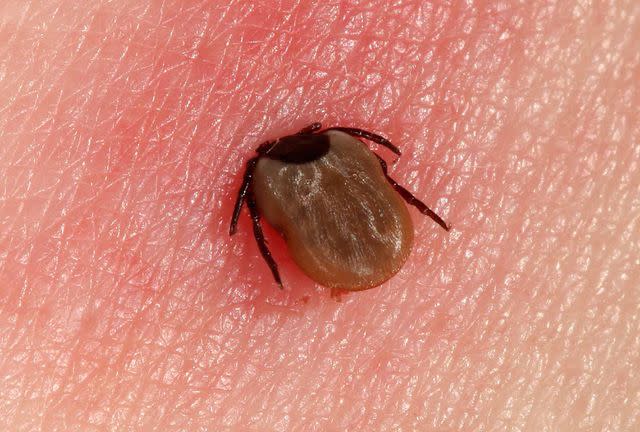How to Identify a Tick Bite (and Prevent Future Bites)
Medically reviewed by Daniel More, MDMedically reviewed by Daniel More, MD
A tick bite occurs when a tick pierces the skin and attaches itself to a warm-blooded host. Once attached, a tick may feed on its host’s blood for several days. Most tick bites are harmless and do not cause symptoms, but they can also cause allergic reactions or pass the disease to humans and pets.
Ticks are parasitic arachnids that feed on blood. They're usually found in wooded or grassy areas and can carry pathogens that cause illnesses. Lyme disease is by far the most common tick-borne illness, with almost 500,000 cases reported annually in the United States.

Aleksey Matrenin / Getty Images
What Does a Tick Bite Look (and Feel) Like?
The appearance of tick bites can vary based on each person's skin reaction, the type of tick, and the duration of its attachment. Because a tick’s saliva contains a numbing agent, most tick bites are painless and initially go unnoticed. The sooner a tick bite is identified and the faster an attached tick is removed, the better. The longer a tick stays attached, the greater the risk of tick-borne disease. It is important to check your skin for ticks after being outdoors.
A tick bite may first appear as a small bump. Or if the tick is carrying Lyme disease, the bite may present as a classic bull's-eye rash (erythema migrans) that's usually about 2 inches across initially but can grow to 12 inches or more over a few days.
A tick will not detach from a host's skin until it's completed a blood meal or is removed with tweezers. Often, the first warning sign of a tick bite is the sensation of something strange rubbing against your skin or the disconcerting feeling that something's latched on when an attached tick gets snagged.
When a tick is doing what is called "questing" for a new warm-blooded host, it typically clings onto a blade of grass and waits for a person or animal to brush by so it can climb aboard.
Once on board, the tick migrates to a warm and moist location on the body that's often hidden from view, where it bites the skin, attaches itself, and starts feeding. Ticks most commonly bite people on the thigh, waist, or stomach, but they can attach themselves to any part of the body.
Full-Body Check: Look Everywhere for Ticks
Ticks are crafty when it comes to finding out-of-sight bite sites. After being in a woodsy or grassy area, check everywhere for ticks, including your belly button, behind your ears, and between your toes.
Although tick bites usually start out painless, noteworthy tick bite symptoms, such as redness (erythema), bite-site swelling (edema), inflammation or itchiness may develop over time. It may be more difficult to detect in children with darker skin tones as it can be mistaken for a bruise and overlooked by healthcare providers. For some people with allergies, a tick bite can cause immediate and intense itching due to the toxins and irritants in tick saliva.
If a disease-carrying tick remains attached for more than four to 24 hours, more serious body-wide (systemic) tick bite symptoms may develop, such as:
Achy joints
Chills
Fatigue
Headache
Tick vs. Other Insect Bites
Finding a tick attached to your skin clearly indicates that a tick has bitten you. Unlike other insects that only bite for a matter of seconds, ticks can stay attached to a host's skin for hours or even days while feeding on a blood meal.

Reproduced with permission from ©DermNet dermnetnz.org 2023.
What Do Ticks Look Like?
Ticks can have a hard shell or a soft, leathery body. Hard-shelled ticks, such as the black-legged (deer) tick, look like a shrunken watermelon seed with even-paired legs attached to each side of the shell, known as a scutum. As their name implies, soft ticks don't have a hard shell and look like tiny beans with legs underneath the body. Ticks often look black, but their color can range from a brownish-red mahogany to dark brown.
A tick's size and number of legs change during its lifecycle. During the larval stage, ticks only have six legs, but during the nymph phase and adulthood, they have eight legs (four on each side). A tick's size and overall shape will vary depending on its life stage and whether it recently had a blood meal.
For example, as larvae, biting ticks are much smaller than one might imagine. When a tick larva bites human flesh and attaches itself, it may look tiny, like a poppy seed embedded in the skin. Because immature ticks are only slightly larger than the period at the end of this sentence, their bites and attached bodies are often really hard to identify without a magnifying glass.
On the flip side, when an adult tick is engorged with blood after feeding from a host for a day or two, it can swell to the size of a plump raisin.

Reproduced with permission from © DermNet and © Raimo Suhonen dermnetnz.org 2023.
How to Tell If You’ve Been Bitten by a Tick
When identifying a tick bite, start by looking for a small, inflamed bump that may resemble a mosquito bite but sometimes flatter and probably won't itch.
A baby tick that's bitten may appear no bigger than a tiny dark speck if it stays attached after biting. If an adult tick bites you, it could look flat like a watermelon seed before feeding but might swell up like a plump raisin after a blood meal lasting 24 hours or more.
A rash may develop and grow a few days after a tick bite. A bull's-eye rash is usually a clear indication that a tick has bitten you; this rash is unique to tick bites.
In the United States, ticks are most active from April to September. It's unlikely you'll be bitten by a tick in the dead of winter, but if you're spending time outdoors in tick-prone areas during the warmer months and don't take preventive measures, a tick may bite you. Although most tick bites are harmless, ticks in certain parts of the country carry Lyme disease or other harmful pathogens.
Tick bites associated with Lyme disease are most prevalent in these high-incidence states:
Connecticut
Delaware
Maine
Maryland
Massachusetts
Minnesota
New Hampshire
New Jersey
New York
Pennsylvania
Rhode Island
Vermont
Virginia
Washington, D.C.
West Virginia
Wisconsin
Symptoms of an Allergic Reaction to a Tick Bite
Some people may experience a severe allergic reaction to tick saliva, leading to anaphylaxis marked by intense itching, hives (urticaria), swelling, low blood pressure, or difficulty breathing.
Red meat allergy, medically known as alpha-gal syndrome and sometimes referred to as mammalian meat allergy, is another allergic reaction that people may develop after being bitten by a specific type of tick called the lone star tick.
Symptoms of Tick-Borne Diseases
Flu-like symptoms such as fever, chills, headache, and achiness are commonly associated with tick-borne diseases. Because ticks can carry such a wide variety of pathogens, symptoms will vary. Lyme disease, the most prevalent tick-borne illness, typically starts with a bull's-eye rash that can progress to joint pain and neurological issues if left untreated.
Other tick-borne diseases like anaplasmosis and ehrlichiosis usually cause similar symptoms, such as fever, headaches, muscle aches, weakness, or shortness of breath. Recognizing tick bite symptoms early and seeking medical advice quickly is key to preventing long-term complications.
Symptoms of Rocky Mountain Spotted Fever
Rocky Mountain spotted fever (RMSF) is a very serious tick-borne illness. If not treated promptly, it can be deadly.
Symptoms of Rocky Mountain spotted fever typically appear about three to 12 days after getting bitten by an infected tick:
Abdominal tenderness
Chills
Confusion
Diarrhea
Extreme exhaustion
Fever
Lack of appetite
Light sensitivity
Muscle pain
Nausea
Severe headache
Sore throat
Although Rocky Mountain spotted fever includes reference to a spotted rash in its name, this symptom isn't always present. Not having the spotty rash can make diagnosis difficult.
How Are Tick Bites Treated?
Tick bite treatment involves prompt removal of any attached ticks and managing subsequent symptoms on a case-by-case basis. For example, topical corticosteroids such as hydrocortisone may be applied to the bite site to alleviate localized inflammation. Over-the-counter (OTC) antihistamines such as topical or oral Benadryl (diphenhydramine) can help relieve itchiness.
If you're bitten by a black-legged tick in a region of the country with high Lyme disease risk, a single dose of doxycycline antibiotics may be prescribed as a postexposure prophylaxis (PEP) to prevent tick-borne illness from developing.
How to Remove a Tick at Home
To remove a tick at home, follow these steps:
Prepare: Gather the supplies you'll need: fine-tipped tweezers, rubbing alcohol or 70% to 80% ethyl alcohol, and a sealable bag if you're saving the tick.
Tweeze carefully: Using fine-tipped tweezers, grasp the tick as close to your skin's surface as possible. Pinch the tick's head and mouthparts (not its body) with the tweezers. Avoid squeezing a tick's body; doing so can force pathogens into your skin.
Pull upward steadily: With the tick's head between the tweezers, pull upward in one steady and continuous motion while applying even pressure. Don't twist or jerk the tick. Twisting or jerking can cause a tick's mouthparts to snap off and stay embedded in your skin.
Inspect the area: After removing the tick, examine the bite site with a magnifying glass or zoomed-in photo taken with your phone to ensure no parts of the tick are still embedded.
Clean the bite site: Wash your hands and the bite site with soap and water. Then, disinfect the bitten area with alcohol. Never burn a tick or slather it with nail polish or petroleum jelly.
Tick disposal: Submerge the tick in alcohol to kill it. Then, if you think it might be a disease-carrying tick, place it in a sealed bag to save for identification. Or, to remove the tick permanently, flush it down the toilet. Avoid crushing ticks with your fingers.
Monitor bitten area: For 30 days, monitor the bite site for signs of infection or a tick-borne illness, such as a bull's-eye rash.
When to Contact a Healthcare Provider
Contact a healthcare provider if the tick bite site shows signs of infection, such as pain, erythema (redness), swelling, or purulent discharge (pus). After removing a tick with tweezers, if you notice that some of the tick's mouthparts are still lodged in your skin, seek medical help.
In the hours or days after being bitten by a tick, if a minor, localized skin rash worsens or grows into a bigger bullseye pattern, it could indicate a tick-borne illness requiring treatment. Prophylactic antibiotics may be prescribed if the tick was attached for more than 24–36 hours, especially if you're bitten in a geographic region known for Lyme disease or other tick-borne illnesses.
Speak to a healthcare provider if you experience flu-like symptoms like fever, chills, headache, muscle pain, achy joints, or swollen lymph nodes.
Ways to Prevent Tick Bites (and Tick-Borne Illnesses)
The best way to prevent tick bites is to avoid brushing up against tall grass, shrubs, or greenery where a tick may be waiting to find a warm-blooded host. At home, keep grass trimmed and use wood chips or gravel to create tick-free zones where people traverse frequently, such as from the front door to your car. When walking in nature, stay in the middle of the trail and avoid brushing up against any greenery or tall grass where ticks might be waiting to pounce.
Insect repellents containing 20% to 30% DEET, 10% icaridin (also called picaridin), or 10% EBAAP can be applied directly to the skin and will help prevent tick bites. Preventing tick bites is the best way to prevent tick-borne illnesses.
Clothing can also be treated with insect repellents or permethrin to deter host-seeking ticks from attaching to fabrics. Research suggests that people wearing permethrin-treated outfits get 3.36 times fewer tick bites than those who don't.
Wearing light-colored clothing makes it easier to spot ticks. Choose long sleeves, long pants, and tuck pant legs into each sock's elastic cuff when you're going to be in tick-prone areas.
Taking a shower and thoroughly washing every part of your body within a half hour of returning from a tick-prone environment can rinse off questing ticks before they bite. Putting outdoor clothing in a hot dryer for at least 20 minutes after getting home will kill any ticks hiding on your clothes.
Get Ticks Off Your Body ASAP
If an attached tick is removed as soon as possible and within 24 hours of biting, the risk of Lyme disease is greatly reduced.
Summary
Ticks are tiny black bugs that feed on blood. Their bites are usually painless to start and appear to be harmless, but tick bites can cause flu-like symptoms and diseases that develop over time. A tick bite usually looks like a small bump initially but may grow into a bigger bull's-eye rash. Unlike other insects, ticks attach to the skin for hours or days while biting and feeding on a host's blood.
It's important to remove attached ticks promptly with tweezers as soon as they're noticed. Don't burn or squish a tick. Instead, submerge the tick in alcohol to kill it, then flush it down the toilet. Once removed, wash the bite site with soap and water. Always check for questing ticks that might be crawling on your skin after you've been in a woodsy or grassy area. A thorough full-body check is key to detecting and removing ticks before they bite.
Tick bites should be taken seriously. Seek medical attention if you can't remove a tick entirely, notice signs of infection, experience flu-like symptoms, or develop a fever or rash.
Read the original article on Verywell Health.
